
Vietnamese advertisements in Massachusetts: A linguistic landscape analysis
Wandering on the Internet, the public space people spend most of their time these days, we came across an ‘interesting’ advertisement for a restaurant on the website Vietnamese Business Directory of Massachusetts. To us, Vietnamese who were born and raised in Vietnam, the advertisement was interesting enough to stimulate our curiosity about its owner and maker.
Vietnamese migration
At the moment, it is estimated that about 4,500,000 Vietnamese live outside the country, and nearly half of them are living in America. These people include three main groups, first those who left the country as refugees after the Vietnam War, second those who studied and worked in the former Soviet bloc, and finally those who followed ‘the pattern of human mobility’ after the end of the Cold War ( Blommaert, 2012). Vietnamese diaspora is extremely dynamic. In the last forty years, they have tried to assimilate into the culture of their new host countries while at the same time keeping their original culture. This cultural dynamic is clearly displayed when we look into how they use Vietnamese, their shared means of communication, in advertisements.
Analyzing advertisement is a part of so-called linguistic landscape studies, a branch of sociolinguistics that through analyzing visible language in public space provides ‘a diagnostic of social, cultural and political structures inscribed in the linguistic landscape’ (Blommaert, 2012). The linguistic landscape of the advertisement and menu of Phở Dakao restaurant in Massachusetts can give us some information about the diversity in American society, the Vietnamese diaspora, and how they use both Vietnamese and English.
Authenticity in a super-diverse context
The name of the restaurant “Phở Dakao” indexes directly to the authenticity of Vietnamese food. Phở is one of the most famous Vietnamese traditional dishes that is gaining popularity in America. ‘Dakao’ was the name of a famous business ward in Sai Gon (now Ho Chi Minh City, Vietnam). We put ‘Dakao’ in inverted commas because it is written slightly differently from the proper way according to the official orthographic system in Vietnam. It must be written ‘ Đa kao’ with a small hyphen in the letter D and a small gap between the two words.
The transformation of the letter ‘Đ’ into D is how Vietnamese people changed their language based on English
The difference is not only with the spelling but also with how people would read the word ‘Dakao’. In Vietnamese, the letter ‘d’ is pronounced as /z/, and the letter ‘đ’ is pronounced as /d/, so ‘Dakao’ should be pronounced /zakaʊ/ instead of /dakaʊ/. The transformation of the letter ‘Đ’ into D is how Vietnamese people changed their language based on English, the dominant language in the US. When we look at the menu of the restaurant, we also find that words such as ‘đặc biệt’ and ‘đồ biển’ also have been changed to ‘dặc biệt’ and ‘dồ biển’, which has no meaning in Vietnamese.
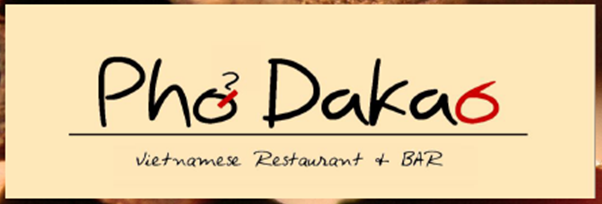
In the advertisement, the two words Phở Dakao were made with some highlights on the hook in the letter ‘o’. With these highlights, the owner not only shows the authenticity of Vietnamese food but also refers to the difference in Vietnamese pronunciation. To pronounce this name properly, speakers should notice the hook in this letter. This also points to the fact that this restaurant is located in a highly diverse context of the US and Massachusetts in particular. Every small detail can mark a distinctive culture in a highly diverse area.
Mixing of Vietnamese and English in the advertisement
Due to the fact that the advertisement of Phở Dakao was posted on a website of the Vietnamese Community in America, there was a mix of Vietnamese and English. This is different from the website of the restaurant itself where English is the only language being used. Information on the main points to attract customers such as food, special views, and convenient parking are written in Vietnamese. The targeted audience of this advertisement, therefore, is Vietnamese people who do not use English or are not proficient in English.
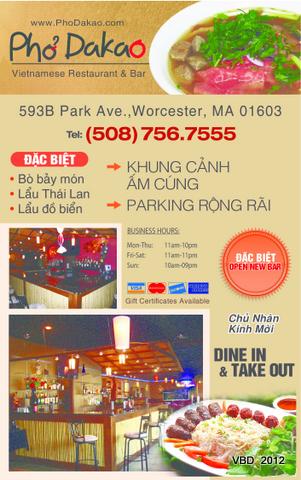
There is however one exception to this, i.e. the information on the opening of a new bar. In view of its positions, coloring, and highlighting, we can conclude that this is a central piece of information in the advertisement. This news includes both Vietnamese and English: ‘Đặc Biệt’ meaning ‘special’ on top and ‘Open New Bar’ below. ‘Open New Bar’ is more important since it is written in stronger red color, but ‘Đặc Biệt’ is written in standardized Vietnamese (not ‘Dặc Biệt’), i.e. targeting Vietnamese customers. The mix of Vietnamese and English in this information can be explained by the fact that ‘Open New Bar’ is a combination of three common English words that every Vietnamese can understand. Most importantly, the sentence ‘Open New Bar’ can be translated into either ‘Mở quán bar mới’, which is not a very polite expression, or ‘Nhà hàng mới mở quán bar’, which is longer and not as impactful as ‘Open New Bar’. The same explanation can be applied to ‘Dine in & Take out’ at the bottom right of the advertisement. The two phrases consist of basic English words that everyone can understand and there is no substitute fixed Vietnamese phrase.
Mixing of Vietnamese and English in the Menu
Looking at the restaurant's menu we observe a deep mix of Vietnamese and English. Most of the dishes are written in Vietnamese names and English names (if any) with English descriptions below. Although the Vietnamese names are written first as the title of the dishes, customers must be fluent in both English and Vietnamese to understand all the information that is provided. Dish number 93, Dậu hũ xào sả ớt is an example. People who do not understand English cannot get information about sliced onions, scallions, and the free service of vegetarian sauce.
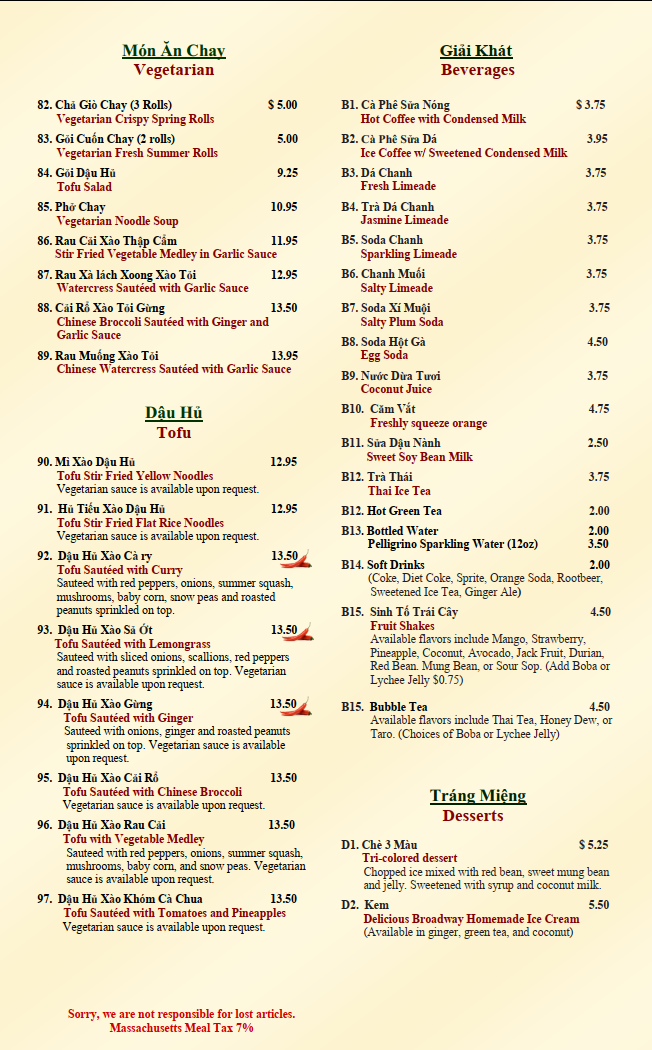
Not all dishes of Phở Dakao restaurant have Vietnamese names. Instead of trying to find the exact Vietnamese vocabulary to express the real names of Vietnamese cuisine, people prefer to use borrowed English words to replace the uncommon, unusual Vietnamese. Also, it is because some exotic vocabularies are more popular and easier for overseas Vietnamese and international customers to understand and remember. To be more specific, we can see from the Pho Dakao restaurant’s menu that "Scallop Xào Rau Cải" is used instead of "Sò Điệp Xào Rau Cải", and "Vẹm Xanh Xào Hành Gừng" is replaced by "Mussel Xào Hành Gừng". The restaurant’s owner may not be familiar with these untypical Vietnamese words, therefore to avoid making mistakes or confusing the customers, the restaurant uses the words ‘Scallop’ and ‘Mussel’ in the menu.
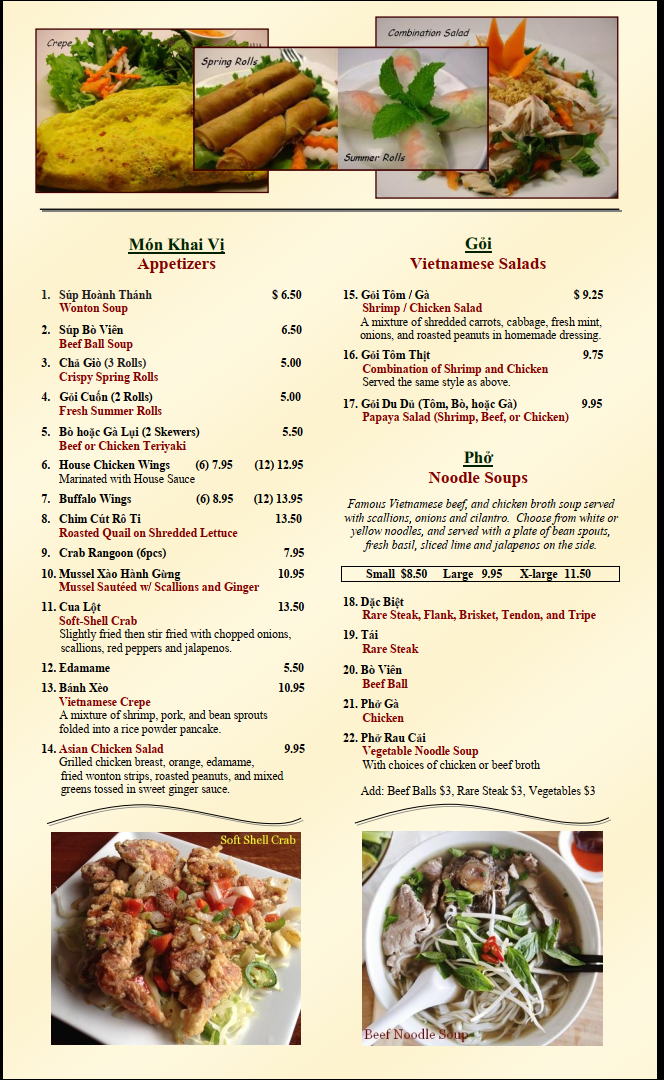
Instead of trying to find the exact Vietnamese vocabularies to express the real names of the Vietnamese cuisine, the maker preferred to use borrowed English words to replace the uncommon, unusual Vietnamese.
Looking at the menu, we can see that this restaurant also serves some dishes from other countries. The names of those dishes are kept in English without any Vietnamese translation. Examples are English “Buffalo wings” and “Crab Rangoon” or Japanese “Edamame” written in the Latin alphabet. It could be explained that even though this is a restaurant specializing in Vietnamese food, these dishes are still popular and widely known by not just American, Japanese, or Asian customers, but also by Vietnamese customers. Therefore, it is not necessary for the names of those foods to be translated into Vietnamese.
According to Blommaert (2012), “in superdiverse environments, people appear to take any linguistic and communicative resource available to them – a broad range, typically, in superdiverse contexts – and blend them into hugely complex linguistic and semiotic forms”. “Edamame” in this case is not an English but a Japanese word which means “steamed green soybeans”. However, since it is a popular dish and the owner wanted to show the most authentic Japanese version, there is no need to get its name explained in different languages. In addition, given the fact that this restaurant does not only serve traditional dishes from Vietnam but also dishes from other countries, it could mean that they focused on Vietnamese customers, but still also Asian and American customers are their target groups. This is reasonable since the restaurant itself is based in America, where the population is (super)diverse with different races, religions, ethnicities, etc. In this context, offering dishes from other countries can be a good strategy to attract all kinds of people.
New or old-styled expression?
Another phrase in this advertisement that must be noticed by Vietnamese people is 'Chủ nhân kính mời’. This phrase can be considered equivalent to the phrase ‘Welcome’, but it represents a weird way of expression in Vietnamese. 'Kính mời Quí khách” is the common phrase being used in restaurants, shops, supermarket advertisements, or welcoming signs in Vietnam, and it can be seen as the proper expression for showing the hospitality of the owners to the customers. Although ‘chủ nhân’ (meaning ‘owner’) and ‘quý khách’ (meaning ‘guest’) are both Sino-Vietnamese words, which are usually used in formal or polite situations, ‘Chủ nhân kính mời’ and ‘kính mời quý khách’ have a very differentiated nuanced meaning. When using ‘Chủ nhân kính mời’, the speaker has the same or a higher position than the receiver; in contrast, speakers lower their position when they use ‘Kính mời Quý khách’. Moreover, the word ‘Chủ nhân’ nowadays rarely appears in daily conversation, but only appears in historical movies or writing contexts. The figure below is a different advertisement on the Vietnamese Community website and the phrase ‘Chủ nhân kính mời’ is also being used.
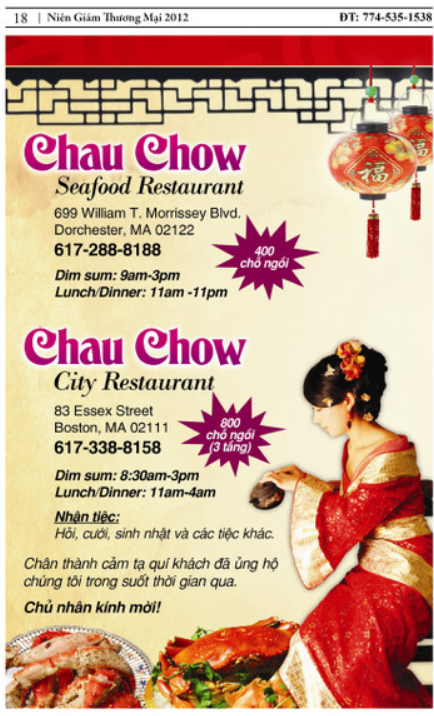
Chau Chow Restaurant advertisement
We have therefore three possible explanations. Option one, the maker wanted to show to have the same level position as the receiver. However, ‘Kính mời’ and ‘Quý khách’ have the same nuanced expression and they both show the respect of the speaker to receivers. Therefore, using ‘Chủ nhân’ with ‘ Kính mời’ seems not to be consistent. Another option is that ‘Chủ nhân kính mời’ is a distinctively fixed phrase in the American Vietnamese Community. And the final option is the old-styled phrase of the maker. It is hard to find the reason why the owner used ‘Chủ nhân Kính mời’ instead of ‘Kính mời Quí khach’. This usage signals the weak connection between the owner as well as the Vietnamese people in Massachusetts with their place of origin Vietnam. Their language proficiency in Vietnamese is too limited to notice this differentiated expression or it might not be outstanding enough for them to take into consideration.
Conclusion
Through doing a linguistic landscape analysis of the advertisement and the menu of Phở Dakao restaurant, we showed three main points. Firstly, in the area characterized as superdiverse, language and culture are always transformed and at the same time kept authentic. This is true with the word ‘Phở Dakao’ since the owner changed it orthographically based on English while highlighting the distinction of Vietnamese pronunciation. Secondly, the mixing of Vietnamese and English in the advertisement and the menu indexes where the restaurant is established, the United States. In this country, with an intense diversity in ethnicities, languages, and cultures, the blending and using of different languages is most probably considered a normal fact of life. Finally, despite the strong connection of the Vietnamese Community in the US, the lacking connections with their original nation resulted in limited proficiency in the Vietnamese language.
References
Blommaert, J. (2013). Ethnography, superdiversity, and linguistic landscapes. Chronicles of complexity. Bristol: Multilingual Matters.
Wikipedia contributors. (2023, February 8). Overseas Vietnamese. Wikipedia